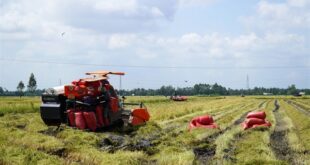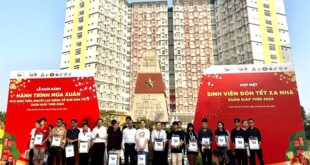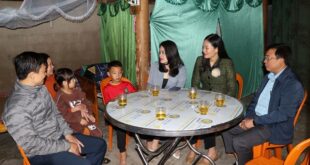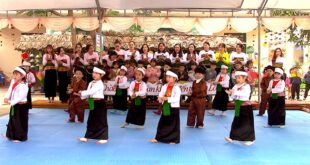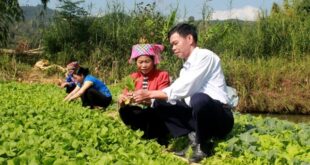
|
| The logo of new rural area development. |
NGHỆ AN — The central province of Nghệ An has set targets that the number of local communes meeting new-style rural area standards will reach over 90 per cent by 2030, with 15 per cent of the communes meeting standards of model new-style rural areas.
Accordingly, by 2030, the Gross Regional Domestic Product (GRDP) growth rate of the provincial agriculture sector should reach an average of 4.6 per cent per year; and the agricultural labour productivity would increase from 5.5 to 6 per cent per year.
The growth rate of industry and rural services is set to reach an average of 10 per cent each year.
The agricultural sector plans to expand and develop markets, especially export markets, with an increase in agricultural, forestry and fishery export values of 5-6 per cent each year.
The average income of rural people in 2030 is targeted to increase 2-2.5 times compared to 2020. The rate of multidimensional poor households in rural areas will decrease by 1-1.5 per cent per year.
The proportion of households in rural areas using clean and hygienic water will reach 95 per cent.
The proportion of agricultural workers in the total number of social workers will be less than 20 per cent. On average, about 50,000 rural workers will receive vocational training every year.
The forest coverage rate will be stable at 58 per cent, improving productivity and forest quality. The forest area with a sustainable forest management certificate will be 50,000 ha. The rate of rural household solid waste, collected and treated according to regulations, will reach 80 per cent.
By 2045, local farmers will have high incomes. The province is planned to have a sustainable, ecologically-developed agricultural sector; large-scale production of goods with high economic value that is closely connected with domestic and foreign markets; and a modern agricultural product processing and preservation industry.
Implementation
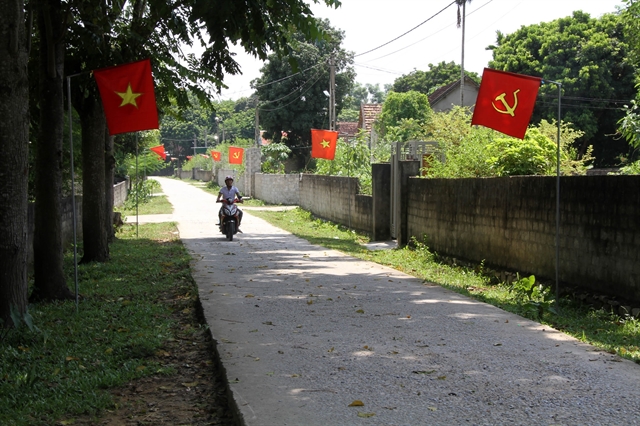
|
| A rural road, built under the new-style rural area programme, in Quỳ Hợp District in the central province of Nghệ An.—VNA/VNS Photo Văn Tý |
To reach these goals, the provincial administration and relevant agencies have disseminated and implemented policies of the Party and laws of the States on agriculture, farmers and rural areas.
The province has also planned to enhance the role, position and ability of local farmers, comprehensively improve their material and spiritual life, especially in disadvantaged rural areas; develop an effective and sustainable agricultural economy in an ecological direction, and apply scientific and technological advances to production, improving quality and added value.
Besides, the province will promote industrial and service development, boost economic restructuring, create on-site jobs for rural workers, and build new-style rural areas in a modern direction associated with preserving traditional culture.
The province has continued to innovate and perfect mechanisms and policies; prioritise resources for agricultural, farmer and rural development; and strengthen research and application of science and technology, innovation, digital transformation and human resource training in agriculture and rural areas.
Managing natural resources, protecting rural environment, improving the ability to adapt to climate change, and preventing and combating natural disasters have been also implemented to reach the goals.
It has boosted international cooperation, market expansion, attracting resources and promoting science and technology transfer; promoted the role of the Việt Nam Fatherland Front, the Farmers’ Association and other organisations in rural areas to fulfil the goals.
Nguyễn Văn Hằng, deputy head of Nghệ An Province’s Standing Office for Coordinating New-style Rural Building, said the province now had 309 new-style rural area communes, 53 communes meeting advanced standards of new-style rural areas, and six communes meeting standards of model new-style rural areas.
He said this was an advantage for the province to run the model of smart new-style rural area commune, defined as a commune that develops digital initiatives for the community; uses solutions, digital resources and agricultural and rural innovations in the socio-economic development of the commune based on three pillars of institutions, people and technology, in order to achieve sustainable development goals, towards the goal of comprehensive digital transformation.
The provincial People’s Committee determined that the implementation of digital transformation in building new-style rural areas was a key solution and task in carrying out the National Target Programme on building new-style rural areas for the period 2021-25, contributing to the realisation of the goal of building ecological agriculture, modern rural areas, civilised farmers and a national digital transformation strategy that were deployed proactively and flexibly with three pillars of developing digital government in rural areas, developing digital economic entities in rural areas, and developing digital society for rural communities. — VNS
- Reduce Hair Loss with PURA D’OR Gold Label Shampoo
- Castor Oil Has Made a “Huge” Difference With Hair and Brow Growth
- Excessive hair loss in men: Signs of illness that cannot be subjective
- Dịch Vụ SEO Website ở Los Angeles, CA: đưa trang web doanh nghiệp bạn lên top Google
- Nails Salon Sierra Madre
 VnExpress News The News Gateway of Vietnam
VnExpress News The News Gateway of Vietnam
